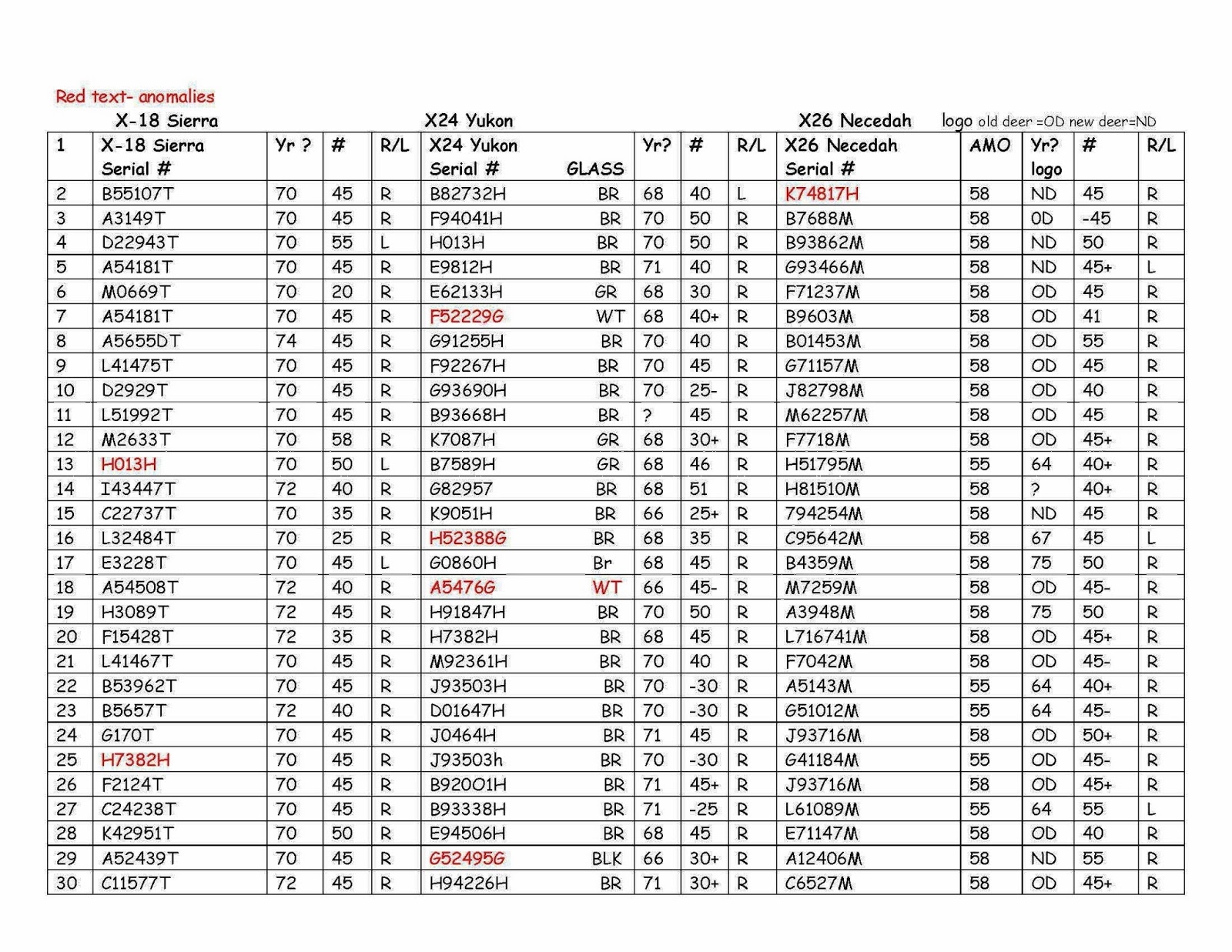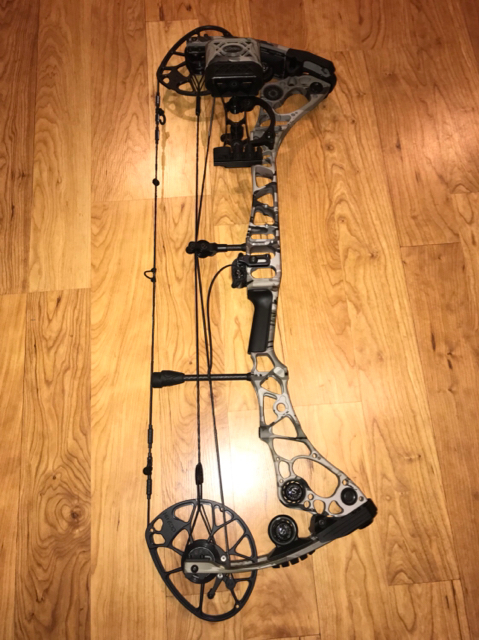The patented construction of this bow (patent No. 2,256,946) permits the use of only the hard outside shell of the bamboo in full length strips which are tapered from the handle to the ends of the bow. The natural contour of the bamboo is followed in gluing and is protected by a backing of vulcanized fibre. Deep narrow handle with. It is a bear archery white tail hunter from the early 80's, the serial number is wh-482990, i don't know if that will help. The hardware functions but is rusty and corroded, the parts that hold.
- Bear Archery Compound Bow Serial Number Lookup Diagram
- Bear Archery Compound Bow Serial Number Lookup Online
- Bear Archery Serial Number Dating
- Bear Archery Serial Number Lookup
- Bear Bow Serial Numbers
 There are several features and changes that were made to the bear bows over the years that will help narrow the age of your bow or your potential investment.
There are several features and changes that were made to the bear bows over the years that will help narrow the age of your bow or your potential investment.1. The Serial Number: These bows usually have, what appears to be a hand inscription on one of the limbs that gives a serial number along with the length and pull weight of the bow. This serial number works very well for dating Bear Bows from 1965-1969 when the first digit of the serial number is the year of manufacture.
For example, a serial number of 5L212 would be a 1965 Bow.
Prior to 1965, the serial numbers for all Bear bows were started over every month, making these bows almost impossible to date by serial number alone. The 'K' series of serial numbers (for example KZ9672) were started in 1970.
2. Patent Mark: Most of the BEAR Bows we have sold have the logo and the US Patents printed on it along with the date of CANADA 1953. This date that is printed on all bows made between 1953 and 1972 is simply the date of the patent for a working recurve limb and has nothing to do with the actual model year.
3. Decals & Silkscreening: In 1948 the small Running Bear decal was first and then was replaced by the large Standing Bear decal in mid-1953. The large Standing Bear decal also has the words 'Glass Powered Bow' under the Standing Bear.
The large Standing Bear decal was used until 1955 when it was replaced with silk-screening the identification on the bows. By 1956 the silk-screening appeared on all bows.
4. All Wood vs Laminate: If your bow is ALL wood (no laminations of any kind) then your bow had to be made before the mass productions beginning in 1949.
- If the ALL wood bow has a stamp that reads 'Bear Products' in some form it would have been made before the early to mid 40's.
- If it is stamped 'Bear Archery' it would have been made AFTER the early-mid 40's and BEFORE 1949.
- Also wooden bows with a small 'Running Bear' decal can be dated to 1948
6. The Coin Medallion: Beginning in 1959 all Bear bows had a coin medallion of one type of metal or another. Below are the approx date ranges for the type of coin used.
Copper Coin – 1959
Aluminum - 1960-1961
Pewter – 1962
Brass - 1963 – 1970
Nickel-Silver - 1971-1972
ALL coins were flush with the wood until 1972. In late 1972 the coin was raised above the surface of the bow and came in both gold and chrome covered plastic and are still used in Bear bows today.
7. Manufacturer Location: in 1978 Bear moved all manufacturing and offices to Gainesville, Florida. If your bow shows Gainesville on it then it was made after 1978
8. Model Of The Bow: Check the Model of the bow. Below is a yearly production chart for the most popular Bear Bows.
Wood Handle Take-Down 1969-1972
Wood C-Riser Victor Custom 1973-1975
Magnesium Handle Take-Down A-B-C 1971-1978
Kodiak Static Recurve 1950-1953
Kodiak Recurve 1954-1966
Super Kodiak 1967-1976
Bear Archery Compound Bow Serial Number Lookup Diagram
Grizzly Static Recurve 1949-1957Grizzly Recurve 1958-1978
Super Magnum 48 1966-1976
Kodiak Magnum 52' 1961-1977
Kodiak Hunter 58' and 60' 1967-1977
Tamerlane 1962-1968
Tamerlane HC-30 1965-1967
Tamerlane HC-300 1968-1972
Kodiak Special 1955-1967
Temujin 1968-1970
 Tarter 1968-1972
Tarter 1968-1972Victor Patriot 1973-1977
Victor 1972
Polar (recurve) 1957-1970
Alaskan (leather grip semi-recurve) 1959-1961
Alaskan (recurve) 1966-1970

Tigercat 1964-1978
Bearcat 1964-1971
Black Bear 1972-1978
Little Bear 1965-1978
Bear Archery Compound Bow Serial Number Lookup Online
With this information you should be able to get really close to dating your Bear Bow if not pin-pointing it to the year.

Nothing has grown so fast and furious in the hobby of Archery Collecting anywhere near the growth that collecting Bear Archery memorabilia has. It doesn't seem to matter what the item is, be it broadhead, bow, catalog, or even LP record albums of Fred telling hunting stories, if it says Bear Archery on it, someone wants it bad!

In this article, I will present an overview of Bear Archery, and give you just a taste of the different items which you should be looking for. Then in later columns, we can get into the details of particular items. But for now, sit back and enjoy our time capsule of the most famous archery company of all time.
Begun in 1933 in a small shop in Detroit, the company was first known by the name Bear Products Company. Archery consumed only a small corner of this new business whose main line was silk-screening and other advertising work for the major automotive makers. Although Fred made bows for himself and friends, it wasn't until 1938 when Fred hired a very skilled woodworker from Detroit by the name of Nels Grumley that the Bear Products Company line expanded to include bows.
By 1940 the archery line had grown to the point where Fred decided to sell out his part of the advertising business to his partner and continue to pursue his hobby/business as the Bear Archery Company. Times were tough, but Fred was a very good business man, and the business continued to grow until the move from Detroit to a brand new plant which Fred had completed in Grayling in 1947.
Fred sold the company in 1968 to Victor Comptometer so that he could raise the needed capitol to grow the company even more. Even though he was not the owner any longer, Fred stayed on as President of Bear Archery Company under Victor. The Bear Archery Company thrived in Grayling until 1978 when a strike at the plant forced the owners to move operations to Gainesville, Florida where the company remains today. Fred stayed active with the company that bears his name until his death in 1988 at the age of 86.
Now that we know a little about the Companies roots, let's take a look at some of the more popular products which have been produced by Bear over the last 65 years.
Without a doubt, Bear Archery Company has produced more traditional bows than all the other traditional bow companies combined. In fact, in one year alone (1975), Bear Archery made over 360,000 bows. Why then, if there are so many Bear bows out there, are they so valuable? Wouldn't it make sense that other bow companies who made fewer bows would be rarer, and thus command more value? Well, remember that we are talking about bowhunters here, ever worse than that we are talking about bowhunters who collect. Enough said?
Seriously, Bear bows were the best marketed bows in the world for over 50 years. Most all of us who grew up in the days before compounds saw Bear ads and promotions everywhere we turned. And as a result, many of us grew up with Bear bows in our hands for a good part of our lives.
Bear Archery Serial Number Dating
Fred’s first bowyer back in 1938 when the fledgling Bear Products Company first began commercially producing bows was a remarkable man by the name of Nels Grumley. Nels was a fantastic craftsman, and his skills show in each and every one of his bows. The pride in his craftsmanship is demonstrated in that each and every bow which Nels made is either stamped or signed with his name, along with the words 'Bear Products by Grumley' or 'Bear Archery by Grumley'.
Beginning in 1938, Grumley bows bore the stamped mark of the maker, sometime in the early 1940’s, the stamp was broken and all bows after that date bore the written mark of their famous maker.
Bear Archery Serial Number Lookup
Why the different means of signing the bows? Well, when Nels first began making bows for Fred in 1938, he used a sort of branding iron to stamp into the wood his mark 'Bear Products by Grumley'. Then somewhere in the early 1940’s, the brand was dropped and broken and instead of buying a new one Nels simply began writing his name on the bows.
Bear Bow Serial Numbers
Note: Remember that the company was known as Bear Products until 1940, so the 'Bear Products by Grumley' bows were obviously made before those marked 'Bear Archery by Grumley'.
Nels left Bear in 1948 when Fred made the decision to begin mass production of bows at the new factory in Grayling. Nels felt strongly that bows should be individually crafted, and not made by machine. So Nels left, even though Fred tried to convince him to stay with some handsome financial offers, and struck out on his own to make bows. However, his private venture into the bow making business lasted only two years before he took a job in an appliance manufacturer as a model maker. These 'Grumley by Grumley' bows are marked with a simple stamped signature 'Grumley' either on the limb or on the riser, and are very scarce and excellent collector items.
Not all Bear bows made in these early years were made by Nels. There were dozens of other bowyers who made Bear wooden bows, mostly the lower line lemonwood models such as the Ranger. These bows were simply marked 'Bear Archery' in a written form. However, in late 1948 Bear began using what later became known as the small 'Running Bear' decal, and thus some bows built beginning in 1948 may have this decal instead of the written brand.
Models of Grumley bows
Nels made 4 basic styles of bows: